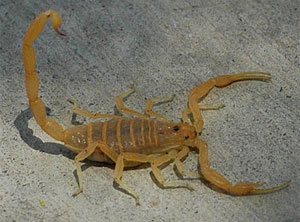How to treat scorpion stings
 Scorpions, part of the arachnid class, can look like something out of a horror movie. Like spiders, they have eight legs, thin pinchers (called pedipalps), and a venomous stinger on their tail. The average size of a scorpion is about 6 cm, but the largest known scorpion grows up to 21 cm! There are hundreds of types of scorpions. Thankfully, most of them are harmless, but a small handful – yikes! – of them can be dangerous and even potentially lethal to humans. Scorpions are found on all continents besides Antarctica, though in some places such as New Zealand and Great Britain they are not naturally occurring. Scorpions may be found in, basically, every ecosystem, as they are incredible adapters and are able to survive on even just one insect a year by altering their metabolism!
Scorpions, part of the arachnid class, can look like something out of a horror movie. Like spiders, they have eight legs, thin pinchers (called pedipalps), and a venomous stinger on their tail. The average size of a scorpion is about 6 cm, but the largest known scorpion grows up to 21 cm! There are hundreds of types of scorpions. Thankfully, most of them are harmless, but a small handful – yikes! – of them can be dangerous and even potentially lethal to humans. Scorpions are found on all continents besides Antarctica, though in some places such as New Zealand and Great Britain they are not naturally occurring. Scorpions may be found in, basically, every ecosystem, as they are incredible adapters and are able to survive on even just one insect a year by altering their metabolism!
Let’s shed some more light on scorpions: Did you know that they glow when placed under ultraviolet light? No one is quite sure why this occurs; it may be a warning signal to possible predators or even a way to lure their prey. Either way, it is definitely pretty creepy.
For the most part, the scorpion’s venom is adapted to their lifestyle, and since their diet mostly consists of insects, their venom is typically relatively harmless to humans. Only about 25 species of scorpions are known to be lethal to humans; the majority of these are part of the Buthidae family. The two most common lethal scorpions found in the United States are the Arizona Bark Scorpion and the Striped Bark Scorpion. The Arizona Bark Scorpion is mainly found in the Southwest United States; fatalities from the sting of this scorpion are rare and the greatest risk is for the elderly and young children. The Striped Bark Scorpion is found more in the Central South and the Midwest of the United States; death is also fairly rare with the Striped Bark Scorpion, but the sting can be extremely painful.
So what happens if a human gets stung by a scorpion? Some common symptoms of a scorpion sting are a tingling or burning at the sting site, numbness, difficulty swallowing, difficulty breathing, blurry vision, or seizures. In some rare cases, pancreatitis – a painful inflammation of the pancreas – may occur. Some symptoms of pancreatitis are abdominal pain, chills, fever, sweating, and nausea. Onset of symptoms is usually quite rapid and can last for between 24 to 48 hours.
If stung by a scorpion, the first thing to do is to make sure you get yourself out of harm’s way and avoid another sting. If possible, try to remember what color the scorpion is or snap a photo with your smartphone; do NOT try to catch the scorpion because you might end up getting stung a second time!
Once out of harm’s way, call 911 and then wash the sting site with soap and water, apply a cold compress for “10 minutes on, then 10 minutes off.” Importantly, avoid aspirin or ibuprofen (such as Advil or Motrin) because these can cause the venom to spread through the body more quickly. Acetaminophen (such as Tylenol) can be taken to help relieve the pain at the site of the sting. Sometimes even more powerful pain medications, like opiates, are required to help alleviate pain. Taking an oral antihistamine such as diphenhydramine (such as Benadryl) can help reduce some of the swelling and itching, as well. Immobilize the area so as to protect the wound and to help delay spreading the venom through the blood more quickly. Do not attempt suction, and do not cut into the wound; these are just great ways to ensure an infection!
In general, it is a good idea to go and get checked out at the nearest hospital or health clinic if stung by a scorpion – especially if the species of scorpion is unknown.
Leave a Comment